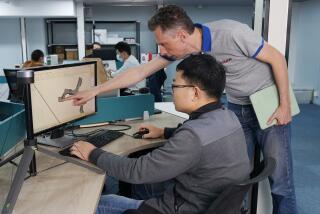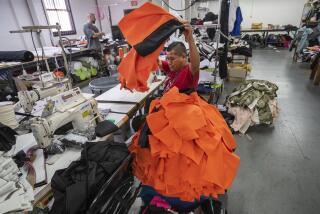Manufacturers group forecasts moderate growth in coming months
- Share via
WASHINGTON — The sharp slowdown in U.S. manufacturing that began last spring appears to be over, setting the stage for moderate expansion in the factory sector in coming months — with a little boost from companies bringing overseas production back to America.
Although exports and backlog orders continued to weaken in December, manufacturers reported increasing shipments and U.S. investment heading into the new year, according to a quarterly survey by the Manufacturers Alliance for Productivity and Innovation, a trade group.
The group’s latest survey, released Thursday, is broadly in line with other industry measures. The government’s jobs report for December showed manufacturing payrolls bounced higher at the end of the year, and the Institute for Supply Management manufacturing index also rose last month above the threshold 50-point mark.
The Manufacturers Alliance report found that 17% of companies with manufacturing operations abroad had brought some of that work back to the U.S. in the last two years.
Such reshoring — or insourcing, as some people call the return of manufacturing from overseas — has been reported in isolated cases over the last few years, but there’s been little in the way of comprehensive data about this phenomenon.
The Manufacturers Alliance’s survey sample was small — 42 large companies with operations abroad — but its findings nonetheless reveal what looks to be a continuing trend.
The survey showed that the seven companies, none of which were identified, that brought back some operations returned it to existing plants rather than new ones.
All of them said the work that was reshored was relatively small or moderate in terms of investment and jobs to the U.S. As expected, America’s gain came at the expense mainly of China, where those operations had been outsourced.
China’s labor costs have been escalating in recent years, while hourly earnings at U.S. factories have barely kept pace with inflation.
U.S. manufacturers paid an average of $35.53 an hour in wages, benefits and labor-related taxes in 2011, versus $47.38 in Germany, $36.56 in Canada and $35.71 in Japan, according to the Bureau of Labor Statistics. Comparable data for China and India aren’t calculated.
Apart from labor rates, U.S. companies moving production back also cited increasing shipping costs and, most notably, “a desire to reduce supply chain uncertainty,” according to the Manufacturers Alliance study.
Concerns about supply chain stability grew after Japan’s massive earthquake and tsunami in March 2011 knocked out vital parts makers in auto, semiconductor and other electronics industries. Lower U.S. natural gas prices and other energy costs weren’t mentioned in the reshoring.
Only six firms, including four that already reshored in the last two years, said they would bring back some operations in 2013. The main reason most others said they have no such plans: “Our activity abroad is geared toward foreign markets, and we need a production platform in these markets.”
The bottom line: Don’t count on reshoring to create a whole lot of domestic jobs or investment any time soon.
“You’re not talking about huge operations coming back; it’s chipping away at the edges,” said Don Norman, the manufacturing group’s senior economist.
Still, any little bit will help. American manufacturing employment has been trending down for decades amid productivity gains and growing foreign competition.
The country has added 530,000 factory jobs since early 2010, but employment largely flattened last year after the first quarter. As of December, manufacturing payrolls were down 1.75 million from five years earlier and nearly 3 million from the end of 2002.
More to Read
Inside the business of entertainment
The Wide Shot brings you news, analysis and insights on everything from streaming wars to production — and what it all means for the future.
You may occasionally receive promotional content from the Los Angeles Times.











